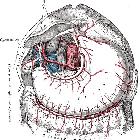Arteria cystica


The cystic artery represents the main blood supply to the gallbladder. It most commonly arises from the right hepatic artery within Calot triangle .
Gross anatomy
The cystic artery typically passes posterior to the cystic duct to reach the neck of the gallbladder. At this point, it gives off two-to-four minor branches, named Calots arteries that supply the cystic duct. The cystic artery then divides into anterior and posterior branches at the neck of the gallbladder:
- anterior (or superficial) branch passes subserously to the left of the gallbladder
- posterior (or deep) branch passes between the gallbladder and the liver parenchyma and ends at the peritoneum at the liver surface; this gives off small branches that supply the gallbladder, and anastomose with the superficial branches
The cystic artery is part of the contents of Calot triangle. Cystic veins do not accompany the cystic artery, rather venous drainage of the gallbladder is via numerous small veins directly into the liver through the bed of the gallbladder and/or into the right portal vein within the liver .
Variant anatomy
Variants are common:
- double cystic artery
- incidence of 2-15%
- both originate from the right hepatic artery and divides into the anterior and posterior branches at their origin
- one of the arteries may arise from the common hepatic artery proper, common hepatic artery, left hepatic artery or gastroduodenal artery
- origin of the cystic artery can vary in 2-5% of cases , most commonly from
- common hepatic artery
- left hepatic artery
- gastroduodenal artery
- variant right hepatic artery
- superior mesenteric artery
- directly from liver parenchyma
- if the artery deviates from its usual anatomy, it will usually run anterior to the cystic and bile ducts
- if the cystic artery arises from the superior mesenteric artery, it ascends to the gallbladder below the cystic duct
Siehe auch:

 Assoziationen und Differentialdiagnosen zu Arteria cystica:
Assoziationen und Differentialdiagnosen zu Arteria cystica:
